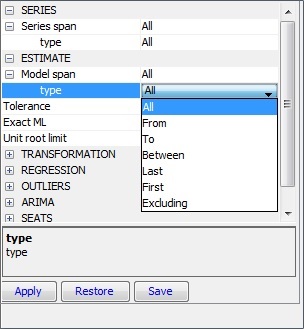Series span and model span
By default, JDemetra+ performs an analysis on the whole span available for a time series. However, in some cases there is a need to limit an analysis to a subset (span) of the time series.
According to the Guidelines on seasonal adjustment (2015), “in the context of seasonal adjustment it is possible to assume heuristically that long time series are those exceeding twenty years of length. Performing seasonal adjustment of long time series can be difficult. Over such a long period the underlying data generating process may change, determining changes also in the components and in the components structure. In this case, to perform the adjustment over the whole series may produce sub-optimal results, mainly in the most recent and the initial parts of the series. Therefore it is reasonable to limit long time series to the most recent observations”.
Another case in which the limitation of a time series can be considered is the presence of a peak in the spectrum from the seasonally adjusted series or irregulars1. Also a change to the method or timing of data collection might be a reason for a shortening a time series.
JDemetra+ offers two useful options to deal with the issue of the length of time series: Model span and Series span.
With the Series span the user can determine a sub-series on which he wants to run the seasonal adjustement or modelling process.
Then he can determine an even shorter Model span, which is the sub-series on which the pre-adjustement regressions and the Arima model will be estimated. This option can be chosen when, for example the user does not want data early in the series to affect the forecasts, or, alternatively, data late in the series to affect regression estimates used for the pre-adjustment.
The final modelling and decomposition of the series will be performed on the Series span using the settings determined with the Model span.

The Model span options
Both Tramo-Seats and X-13ARIMA-SEATS offer the same set of options for Series span and Model span parameters.
-
Guide to seasonal adjustment with X-12-ARIMA (2007). ↩